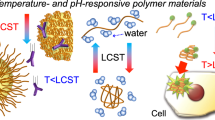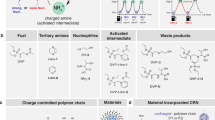Abstract
STIMULI-responsive polymers exhibit reversible phase changes in response to changes in environmental factors such as pH or temperature1–14. Conjugating such polymers to antibodies and proteins provides molecular systems for applications such as affinity separations, immunoassays and enzyme recovery and recycling15– 25. Here we show that conjugating a temperaturesensitive polymer to a genetically engineered site on a protein allows the protein's ligand binding affinity to be controlled. We synthesized a mutant of the protein streptavidin to enable sitespecific conjugation of the responsive polymer near the protein's binding site. Normal binding of biotin to the modified protein occurs below 32 °C, whereas above this temperature the polymer collapses and blocks binding. The collapse of the polymer and thus the enabling and disabling of binding, is reversible. Such environmentally triggered control of binding may find many applications in biotechnology and biomedicine, such as the control of enzyme reaction rates and of biosensor activity, and the controlled release of drugs.
This is a preview of subscription content, access via your institution
Access options
Subscribe to this journal
Receive 51 print issues and online access
$199.00 per year
only $3.90 per issue
Buy this article
- Purchase on Springer Link
- Instant access to full article PDF
Prices may be subject to local taxes which are calculated during checkout
Similar content being viewed by others
References
Hoffman, A. S. Artif. Organs 19, 458–467 (1995).
Heskins, M. & Guillet, J. E. J. Macromol. Sci. Chem. A2(8), 1441–1455 (1968).
Tanaka, T. Scient. Am. 244, 124–138 (1981).
Cussler, E. L., Stokar, M. R. & Varberg, J. E. Am. Inst. Chem. Eng. J. 30, 578–582 (1984).
Ishihara, K., Hanada, N., Kato, S. & Shinohara, I. Polymer J. 16, 625–631 (1984).
Hoffman, A. S. J. contr. Rel. 6, 297–305 (1987).
Brannon-Peppas, L. & Peppas, N. A. J. contr. Rel. 8, 267–274 (1989).
Irie, M. Adv. Polym. Sci. 94, 28–67 (1990).
Kabra, B. & Gehrke, S. H. Polymer Commun. 32, 322–323 (1991).
Kwon, I. C., Bae, Y. H. & Kim, S. W. Nature 354, 291–293 (1991).
Kokufata, E., Zhang, Y. Q. & Tanaka, T. J. Biomater. Sci. Polym. Ed. 6, 35–40 (1994).
Okuzaki, H. & Osada, Y. J. Biomater. Sci. Polym. Ed. 5, 485–496 (1994).
Chen, G. H. & Hoffman, A. S. Nature 373, 49–52 (1995).
Yoshida, R. et al. Nature 374, 240–242 (1995).
Monji, N. & Hoffman, A. S. Appl. Biochem. Biotech. 14, 107–120 (1987).
Chen, J. P. & Hoffman, A. S. Biomaterials 11, 625–630, 631–634 (1990).
Monji, N. et al. Biochem. Biophys. Res. Commun. 172, 652–660 (1990).
Yang, H. J., Cole, C. A., Monji, N. & Hoffman, A. S. J. Polymer Sci. A28, 219–226 (1990).
Chen, G. H. & Hoffman, A. S. ACS Polym. Preprints 33, 468–469 (1992).
Chen, G. H. & Hoffman, A. S. Bioconj. Chem. 4, 509–514 (1993).
Takei, Y. G. et al. Bioconj. Chem. 4, 42–46 (1993).
Monji, N., Cole, C. A. & Hoffman, A. S. J. Biomater. Sci. Polym. Ed. 5, 407–420 (1994).
Chen, G. H. & Hoffman, A. S. J. Biomater. Sci. Polym. Ed. 5, 371–382 (1994).
Chen, G. H. & Hoffman, A. S. Macromolec. Chem. Phys. 196, 1251–1259 (1995).
Chilkoti, A., Chen, G., Stayton, P. S. & Hoffman, A. S. Bioconj. Chem. 5, 504–507 (1994).
Stayton, P. S., Fisher, M. & Sligar, S. G. J. biol. Chem. 267, 13544–13548 (1988).
Weber, P. C., Ohlendorf, D. H., Wendoloski, J. J. & Salemme, F. R. Science 243, 85–88 (1989).
Burns, J. A., Butler, J. C., Moran, J. & Whitesides, G. M. J. org. Chem. 56, 2648–2650 (1991).
Chilkoti, A., Tan, P. & Stayton, P. S. Proc. natn. Acad. Sci. U.S.A. 92, 1754–1758 (1995).
Kraulis, P. J. appl. Crystallogr. 24, 946–950 (1991).
Author information
Authors and Affiliations
Rights and permissions
About this article
Cite this article
Stayton, P., Shimoboji, T., Long, C. et al. Control of protein–ligand recognition using a stimuli-responsive polymer. Nature 378, 472–474 (1995). https://doi.org/10.1038/378472a0
Received:
Accepted:
Issue Date:
DOI: https://doi.org/10.1038/378472a0
Comments
By submitting a comment you agree to abide by our Terms and Community Guidelines. If you find something abusive or that does not comply with our terms or guidelines please flag it as inappropriate.



